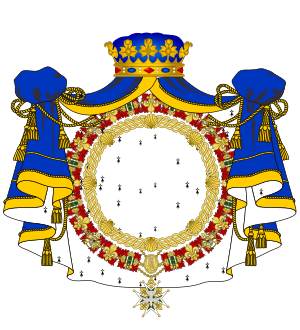Peerage of France facts for kids
The Peerage of France (called Pairie de France in French) was a very special and important title in old France. It was given to only a few of the most powerful and highest-ranking members of the French nobility. Think of it as an exclusive club for the most important nobles!
This special rank appeared around the year 1180, during the Middle Ages. It was a hereditary title, meaning it was passed down from parents to their children. Only a small number of princes, dukes, and counts were given this great honor.
The French Peerage was different from the British peerage. In France, most nobles, even dukes, were not Peers. Only a select few held this unique position. It was similar to the rank of a Grandee of Spain, another very high noble title.
This system of Peers was ended in 1789, during the big changes of the French Revolution.
Contents
What Was a Peer of France?
A Peer of France was a very important person in the French kingdom. They were seen as the king's closest advisors and companions. The word "peer" comes from the Latin word pares, meaning "equals." This showed that they were considered equal to each other in rank, even if not equal to the king.
The First Peers
The very first Peers of France were chosen in the 12th century. There were originally twelve of them, just like the twelve knights of King Arthur's Round Table. These twelve Peers were divided into two groups:
- Six Ecclesiastical Peers: These were high-ranking church leaders.
* The Archbishop-Duke of Reims * The Bishop-Duke of Laon * The Bishop-Duke of Langres * The Bishop-Count of Beauvais * The Bishop-Count of Châlons * The Bishop-Count of Noyon
- Six Lay Peers: These were powerful noblemen.
* The Duke of Burgundy * The Duke of Normandy * The Duke of Aquitaine (or Guyenne) * The Count of Flanders * The Count of Champagne * The Count of Toulouse
These original twelve Peers were very powerful. They had special roles in important royal events, like the king's coronation ceremony.
Roles and Privileges
Being a Peer of France came with many special rights and duties.
- Advisors to the King: Peers were expected to advise the king on important matters of the kingdom.
- Judicial Rights: They had the right to be judged only by other Peers, not by regular courts. This was a very important privilege.
- Ceremonial Duties: Peers played key roles in royal ceremonies, especially the coronation of a new king. They would stand around the king and take part in the rituals.
- High Status: Holding the title of Peer gave them immense social standing and respect throughout France.
Over time, the number of Peers grew beyond the original twelve. New peerages were created, usually for dukes. By the 18th century, there were many more Peers, but the title remained very exclusive.
End of the Peerage
The Peerage of France lasted for several centuries. However, its power and importance changed over time. By the 17th and 18th centuries, the French kings had become more powerful, and the Peers had less direct influence on government decisions.
The Peerage was finally abolished on August 11, 1789. This happened during the French Revolution, a time when many old traditions and noble titles were removed. The idea of a special group of nobles with unique privileges did not fit with the new ideas of equality that the revolution brought.
Although the Peerage of France no longer exists, it remains an important part of French history. It shows how power and society were organized in the kingdom for many centuries.
Images for kids
See also
 In Spanish: Par de Francia para niños
In Spanish: Par de Francia para niños





